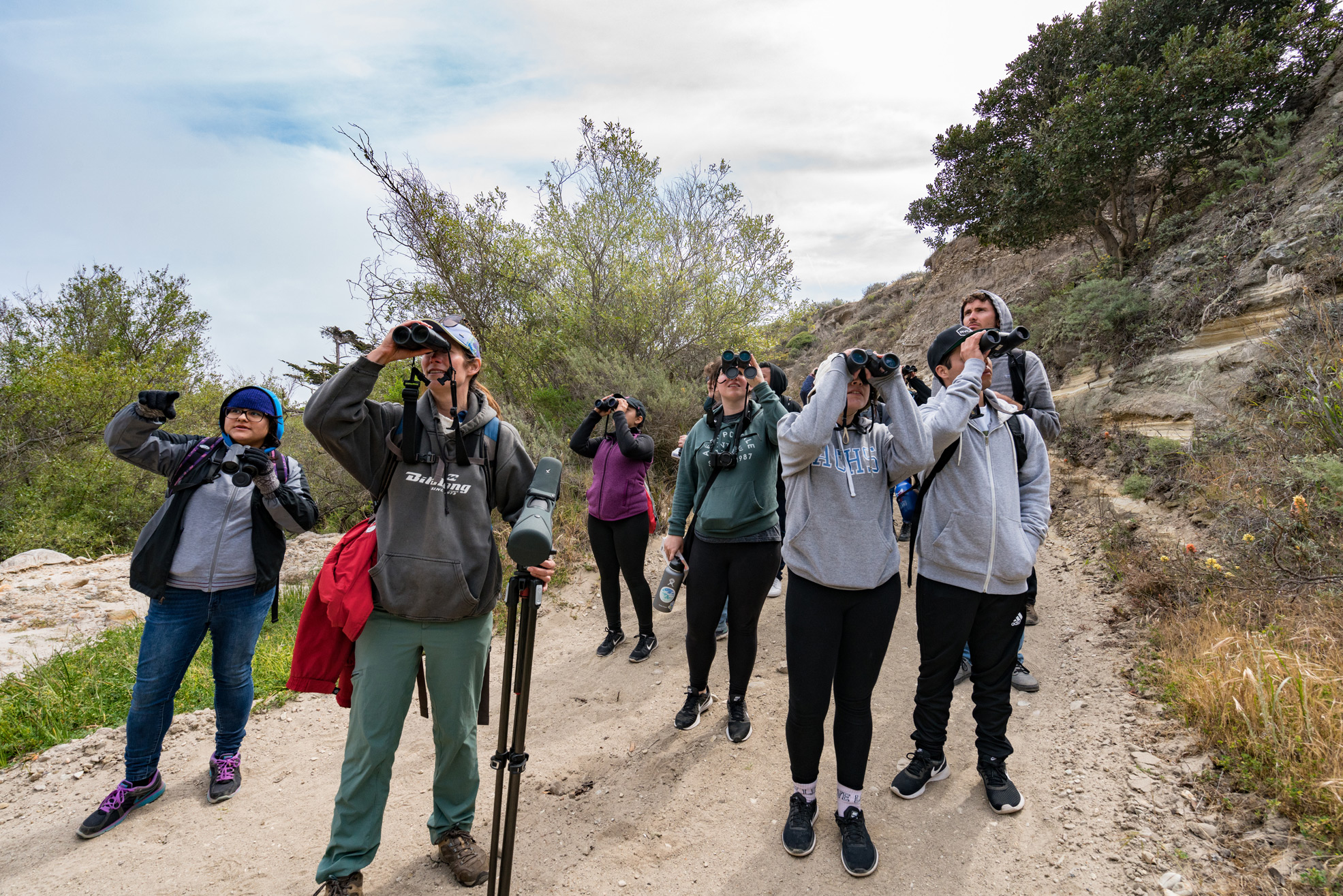Birdwatching at the Santa Rosa Island Research Station
Professor Allison Alvarado Teaches Ornithology to CSU Channel Islands Students

“Who knows what that group is?” asks professor Allison Alvarado to her pack of students, huddling together in a low canyon, hidden from the winds howling across Santa Rosa Island and onto the frigid waters of Bechers Bay.
“Oscine!” yell a couple of students in response.
“Yes,” replies Alvarado, “songbirds.”
“It’s a goldfinch!” declares another student, to which Alvarado chimes in, “Correct. A Lawrence’s goldfinch. See, there’s a lot you can get without even seeing them.”
This teacher-student-songbird banter carries on all morning, from the scrubby bluffs just above the shore —where Pacific-slope flycatchers, western tanagers, and Lazuli buntings carry on, the latter of which adorns The Sibley Birds Westguide that so many of the students hold —to the foothills full of Torrey pine trees, where bald eagles and peregrine falcons are known to lurk.
The second largest isle in the archipelago that makes up Channel Islands National Park, Santa Rosa Island is a particularly enchanted place, and I’ve spent considerable time there over the past two decades. I’ve tracked island foxes and spotted skunks, paddled by and sprinted away from elephant seals on both sides of the island, and been startled by ravens and snakes in those rare pines. I even proposed to my wife on the knoll above Carrington Point.
But I’ve never paid much attention to the smaller birds that are all over the island —more than 30 songbird species are quite common there, explained Alvarado, although about 250 bird species have been tallied over time. I had joined her ornithology class of about 20 students that morning, and I’d never seen so many young adults, all around 20 years old, so enthused about tiny birds and their sweet songs. It gave me hope for the future.
That’s the promise of the Santa Rosa Island Research Station, an outpost managed by California State University Channel Islands that clocks in more than 4,500 user days per year. That includes undergrad students like the ornithology class that I met —they were studying for an upcoming exam about bird vocalizations —as well as K-12 students from Oxnard, classes from community colleges and Westmont, and researchers and volunteers from the Smithsonian and other entities. The university also conducts research —usually spearheaded by professors, collected by undergrads —on archaeology, intertidal biology, and cloud forest restoration, among other topics. But arts, writing, education, and other classes also use the facility, which consists primarily of a modest bunkhouse, complete with a small mess hall.
The station’s creation started with conversations between the National Park Service and the university in 2011. An agreement was signed in 2012, and the first classes headed out in 2013. It’s a mutually beneficial relationship, said Dan Wakelee, a longtime administrator for the university, which is still the youngest CSU in the system, started in 2002.
“With students and others out there collecting data to better understand the park, it helps the [Park Service] to better manage what’s going on out there,” said Wakelee, who’s been trying to retire but currently serves as a consultant for the station. “From the university’s point of view, it gives the students the opportunity to experience field work in a way that they wouldn’t otherwise. They collect data that’s actually used for something, so they get an immersive field experience. For many of them, it’s their first time in a park or in the field. Many of them have come back and talked about how it’s changed their understanding of places like that, or even their career trajectories.”
Alvarado goes even further. “This is going to sound cliché, but for many of them, it’s life changing,” she said, which is also because of how the students must work together as a group, essentially stranded on an island. “Many of them have no idea what to expect. We emphasize how you’re sort of isolated but, at the same time, you are part of this community, all cooking and cleaning together. Most of them haven’t experienced anything like that.” The isolation is useful in other ways too. “It’s also really helpful not having Wi-Fi, so they all bond in this natural setting,” she said. “I think it really does change them. It’s such a great resource for the university.”Back on the island, Alvarado quizzes her students about why one bird is flying away with a bug in its mouth —“For the nest!” a student answers —and how you can tell certain species by the way they flip their tails. They’re all becoming quite adept at identifying the western meadowlark. “It’s one of the most common birds, especially around the ranch areas on the island,” said Alvarado. “Everyone’s learned that song.”
As we walk up out of the small canyon, a student comes up to me, out of the blue. “This is such an excellent class!” exclaimed Ben Anderson. “This is her passion.”
And, from what I saw in my short morning with the class, this research station is firing up quite a few passionate students as well.
See csuci.edu/sri.
More stories from our 2018 Blue & Green issue can be found here.



